Structure of Business Report: Legal Structures, Finance, HR Policies
VerifiedAdded on 2022/11/25
|12
|3743
|370
Report
AI Summary
This report provides a comprehensive analysis of business structures, focusing on various legal statuses such as public companies, private companies, and registered charities, evaluating their strengths and weaknesses. It also assesses different sources of finance available for business start-ups, including loans, venture capital, and debentures, highlighting their advantages and disadvantages. Furthermore, the report examines the sectors within which a business operates in the UK economy, specifically the primary, secondary, and tertiary sectors, and their significance. Finally, it addresses the importance of HR policies in the modern workplace, emphasizing their role in organizational success. The report aims to provide insights into the critical aspects of establishing and managing a business, offering valuable information for students and professionals alike. The report is structured to provide a comprehensive overview of the key elements involved in business operations, from the initial legal structure and financial planning to the ongoing management of human resources and sector-specific considerations.
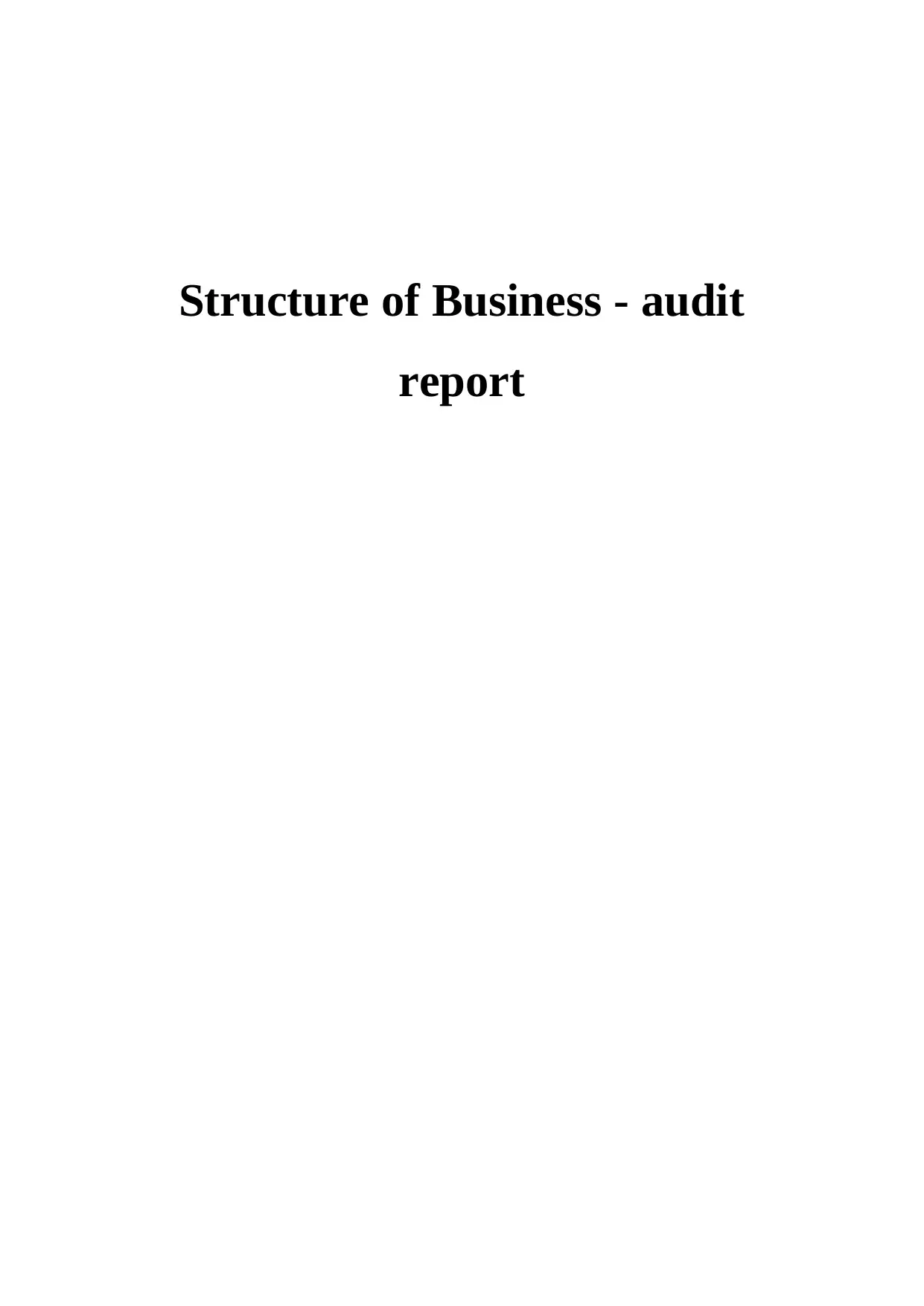
Structure of Business - audit
report
report
Paraphrase This Document
Need a fresh take? Get an instant paraphrase of this document with our AI Paraphraser
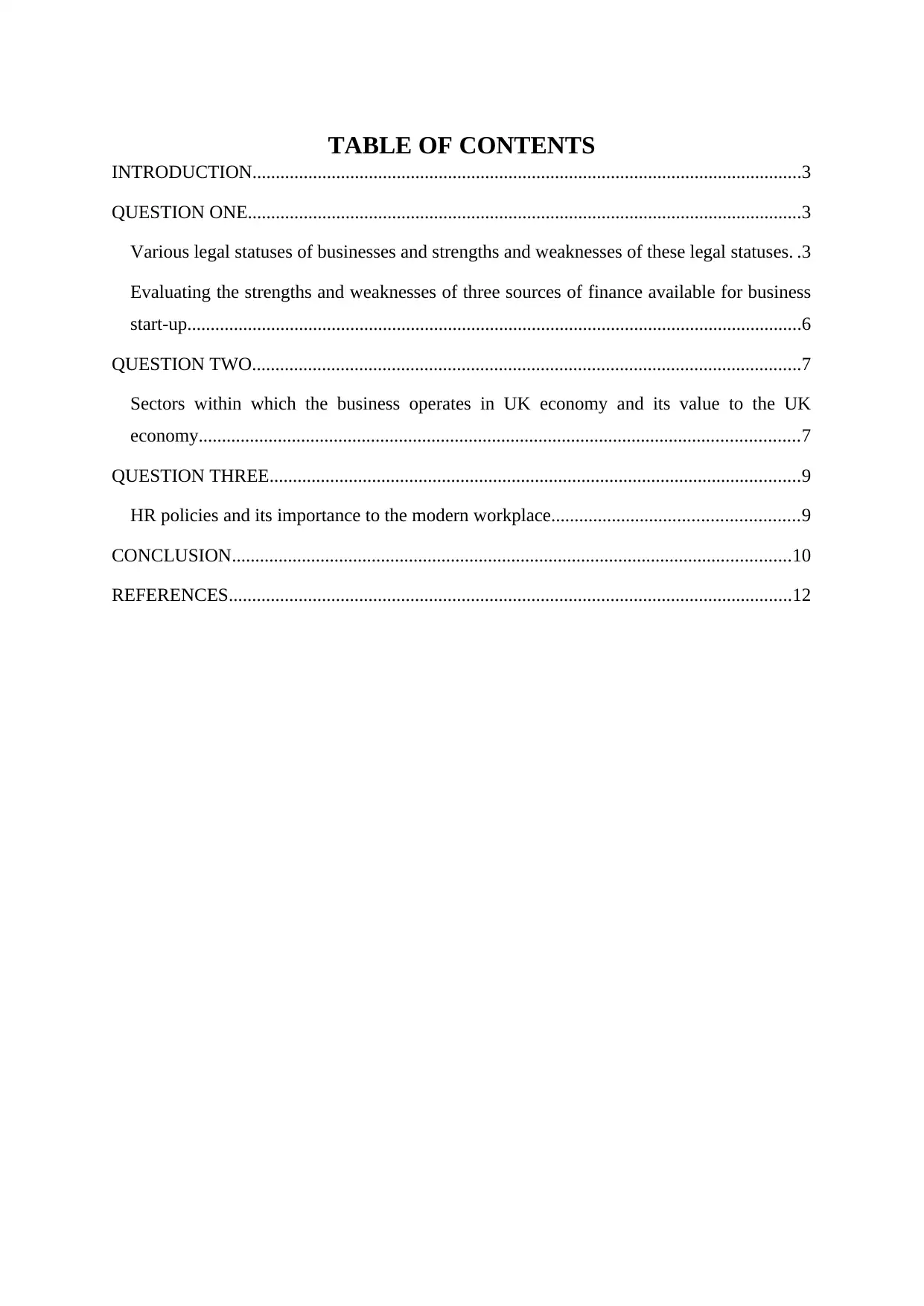
TABLE OF CONTENTS
INTRODUCTION......................................................................................................................3
QUESTION ONE.......................................................................................................................3
Various legal statuses of businesses and strengths and weaknesses of these legal statuses. .3
Evaluating the strengths and weaknesses of three sources of finance available for business
start-up....................................................................................................................................6
QUESTION TWO......................................................................................................................7
Sectors within which the business operates in UK economy and its value to the UK
economy.................................................................................................................................7
QUESTION THREE..................................................................................................................9
HR policies and its importance to the modern workplace.....................................................9
CONCLUSION........................................................................................................................10
REFERENCES.........................................................................................................................12
INTRODUCTION......................................................................................................................3
QUESTION ONE.......................................................................................................................3
Various legal statuses of businesses and strengths and weaknesses of these legal statuses. .3
Evaluating the strengths and weaknesses of three sources of finance available for business
start-up....................................................................................................................................6
QUESTION TWO......................................................................................................................7
Sectors within which the business operates in UK economy and its value to the UK
economy.................................................................................................................................7
QUESTION THREE..................................................................................................................9
HR policies and its importance to the modern workplace.....................................................9
CONCLUSION........................................................................................................................10
REFERENCES.........................................................................................................................12
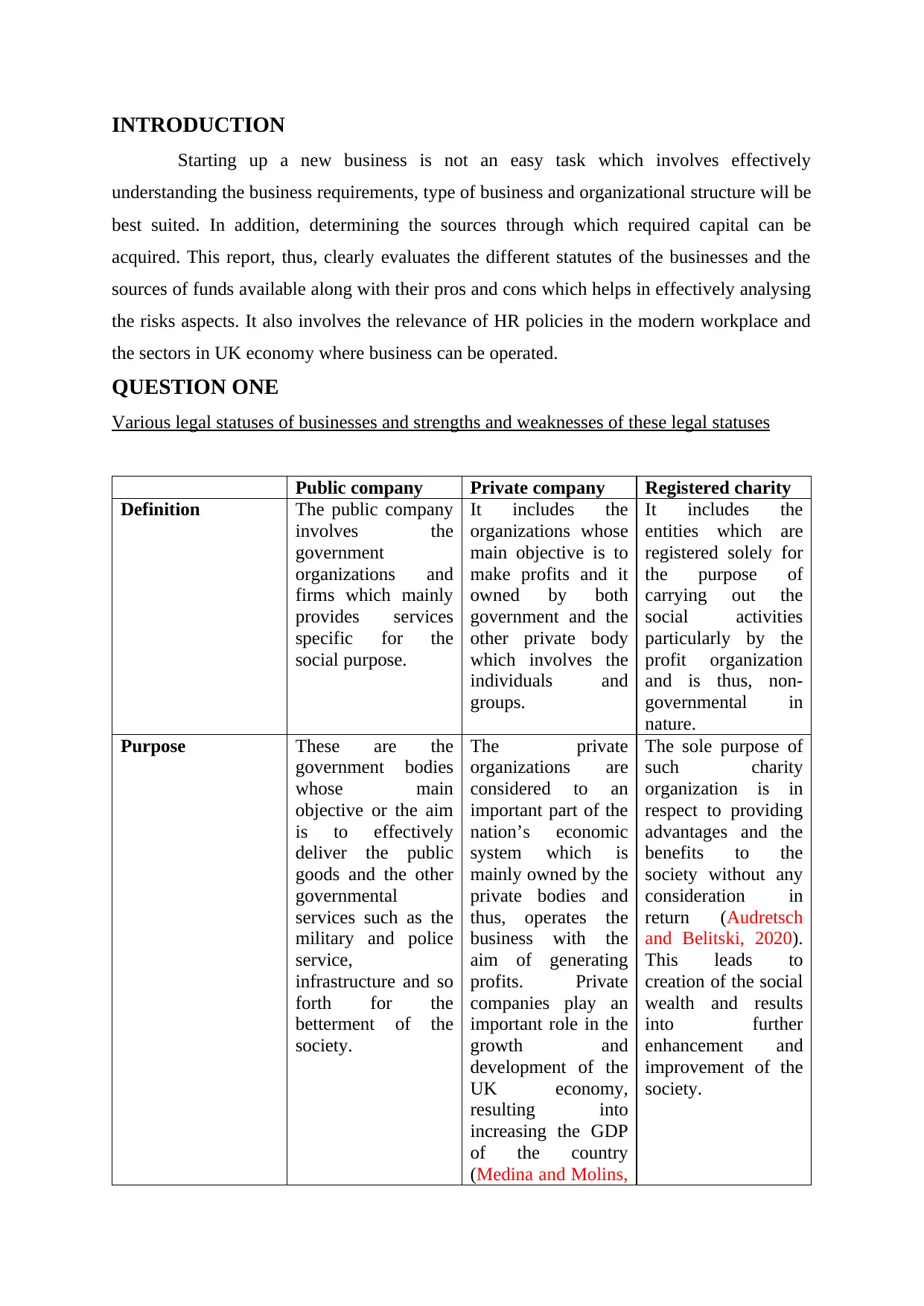
INTRODUCTION
Starting up a new business is not an easy task which involves effectively
understanding the business requirements, type of business and organizational structure will be
best suited. In addition, determining the sources through which required capital can be
acquired. This report, thus, clearly evaluates the different statutes of the businesses and the
sources of funds available along with their pros and cons which helps in effectively analysing
the risks aspects. It also involves the relevance of HR policies in the modern workplace and
the sectors in UK economy where business can be operated.
QUESTION ONE
Various legal statuses of businesses and strengths and weaknesses of these legal statuses
Public company Private company Registered charity
Definition The public company
involves the
government
organizations and
firms which mainly
provides services
specific for the
social purpose.
It includes the
organizations whose
main objective is to
make profits and it
owned by both
government and the
other private body
which involves the
individuals and
groups.
It includes the
entities which are
registered solely for
the purpose of
carrying out the
social activities
particularly by the
profit organization
and is thus, non-
governmental in
nature.
Purpose These are the
government bodies
whose main
objective or the aim
is to effectively
deliver the public
goods and the other
governmental
services such as the
military and police
service,
infrastructure and so
forth for the
betterment of the
society.
The private
organizations are
considered to an
important part of the
nation’s economic
system which is
mainly owned by the
private bodies and
thus, operates the
business with the
aim of generating
profits. Private
companies play an
important role in the
growth and
development of the
UK economy,
resulting into
increasing the GDP
of the country
(Medina and Molins,
The sole purpose of
such charity
organization is in
respect to providing
advantages and the
benefits to the
society without any
consideration in
return (Audretsch
and Belitski, 2020).
This leads to
creation of the social
wealth and results
into further
enhancement and
improvement of the
society.
Starting up a new business is not an easy task which involves effectively
understanding the business requirements, type of business and organizational structure will be
best suited. In addition, determining the sources through which required capital can be
acquired. This report, thus, clearly evaluates the different statutes of the businesses and the
sources of funds available along with their pros and cons which helps in effectively analysing
the risks aspects. It also involves the relevance of HR policies in the modern workplace and
the sectors in UK economy where business can be operated.
QUESTION ONE
Various legal statuses of businesses and strengths and weaknesses of these legal statuses
Public company Private company Registered charity
Definition The public company
involves the
government
organizations and
firms which mainly
provides services
specific for the
social purpose.
It includes the
organizations whose
main objective is to
make profits and it
owned by both
government and the
other private body
which involves the
individuals and
groups.
It includes the
entities which are
registered solely for
the purpose of
carrying out the
social activities
particularly by the
profit organization
and is thus, non-
governmental in
nature.
Purpose These are the
government bodies
whose main
objective or the aim
is to effectively
deliver the public
goods and the other
governmental
services such as the
military and police
service,
infrastructure and so
forth for the
betterment of the
society.
The private
organizations are
considered to an
important part of the
nation’s economic
system which is
mainly owned by the
private bodies and
thus, operates the
business with the
aim of generating
profits. Private
companies play an
important role in the
growth and
development of the
UK economy,
resulting into
increasing the GDP
of the country
(Medina and Molins,
The sole purpose of
such charity
organization is in
respect to providing
advantages and the
benefits to the
society without any
consideration in
return (Audretsch
and Belitski, 2020).
This leads to
creation of the social
wealth and results
into further
enhancement and
improvement of the
society.
⊘ This is a preview!⊘
Do you want full access?
Subscribe today to unlock all pages.

Trusted by 1+ million students worldwide
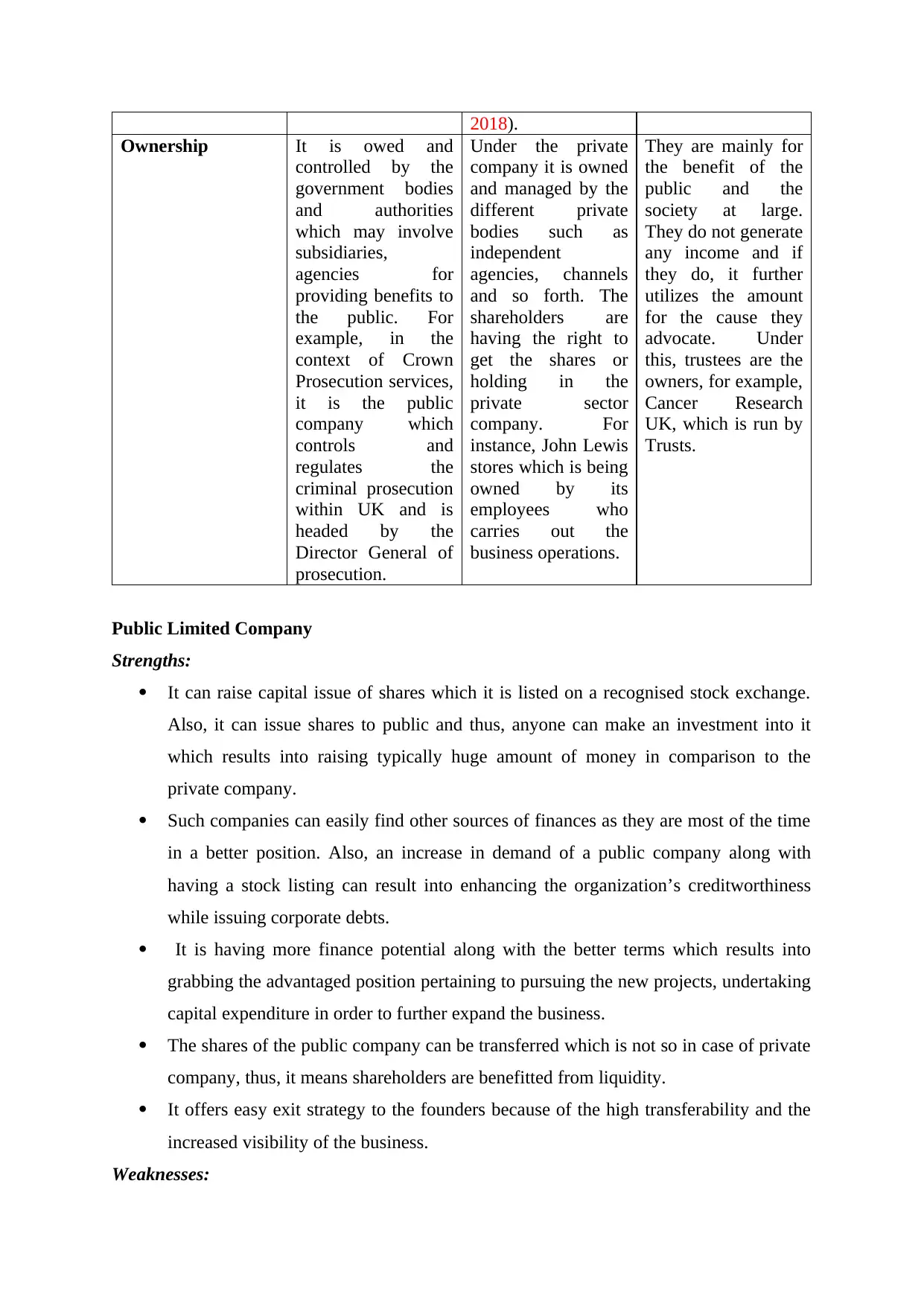
2018).
Ownership It is owed and
controlled by the
government bodies
and authorities
which may involve
subsidiaries,
agencies for
providing benefits to
the public. For
example, in the
context of Crown
Prosecution services,
it is the public
company which
controls and
regulates the
criminal prosecution
within UK and is
headed by the
Director General of
prosecution.
Under the private
company it is owned
and managed by the
different private
bodies such as
independent
agencies, channels
and so forth. The
shareholders are
having the right to
get the shares or
holding in the
private sector
company. For
instance, John Lewis
stores which is being
owned by its
employees who
carries out the
business operations.
They are mainly for
the benefit of the
public and the
society at large.
They do not generate
any income and if
they do, it further
utilizes the amount
for the cause they
advocate. Under
this, trustees are the
owners, for example,
Cancer Research
UK, which is run by
Trusts.
Public Limited Company
Strengths:
It can raise capital issue of shares which it is listed on a recognised stock exchange.
Also, it can issue shares to public and thus, anyone can make an investment into it
which results into raising typically huge amount of money in comparison to the
private company.
Such companies can easily find other sources of finances as they are most of the time
in a better position. Also, an increase in demand of a public company along with
having a stock listing can result into enhancing the organization’s creditworthiness
while issuing corporate debts.
It is having more finance potential along with the better terms which results into
grabbing the advantaged position pertaining to pursuing the new projects, undertaking
capital expenditure in order to further expand the business.
The shares of the public company can be transferred which is not so in case of private
company, thus, it means shareholders are benefitted from liquidity.
It offers easy exit strategy to the founders because of the high transferability and the
increased visibility of the business.
Weaknesses:
Ownership It is owed and
controlled by the
government bodies
and authorities
which may involve
subsidiaries,
agencies for
providing benefits to
the public. For
example, in the
context of Crown
Prosecution services,
it is the public
company which
controls and
regulates the
criminal prosecution
within UK and is
headed by the
Director General of
prosecution.
Under the private
company it is owned
and managed by the
different private
bodies such as
independent
agencies, channels
and so forth. The
shareholders are
having the right to
get the shares or
holding in the
private sector
company. For
instance, John Lewis
stores which is being
owned by its
employees who
carries out the
business operations.
They are mainly for
the benefit of the
public and the
society at large.
They do not generate
any income and if
they do, it further
utilizes the amount
for the cause they
advocate. Under
this, trustees are the
owners, for example,
Cancer Research
UK, which is run by
Trusts.
Public Limited Company
Strengths:
It can raise capital issue of shares which it is listed on a recognised stock exchange.
Also, it can issue shares to public and thus, anyone can make an investment into it
which results into raising typically huge amount of money in comparison to the
private company.
Such companies can easily find other sources of finances as they are most of the time
in a better position. Also, an increase in demand of a public company along with
having a stock listing can result into enhancing the organization’s creditworthiness
while issuing corporate debts.
It is having more finance potential along with the better terms which results into
grabbing the advantaged position pertaining to pursuing the new projects, undertaking
capital expenditure in order to further expand the business.
The shares of the public company can be transferred which is not so in case of private
company, thus, it means shareholders are benefitted from liquidity.
It offers easy exit strategy to the founders because of the high transferability and the
increased visibility of the business.
Weaknesses:
Paraphrase This Document
Need a fresh take? Get an instant paraphrase of this document with our AI Paraphraser
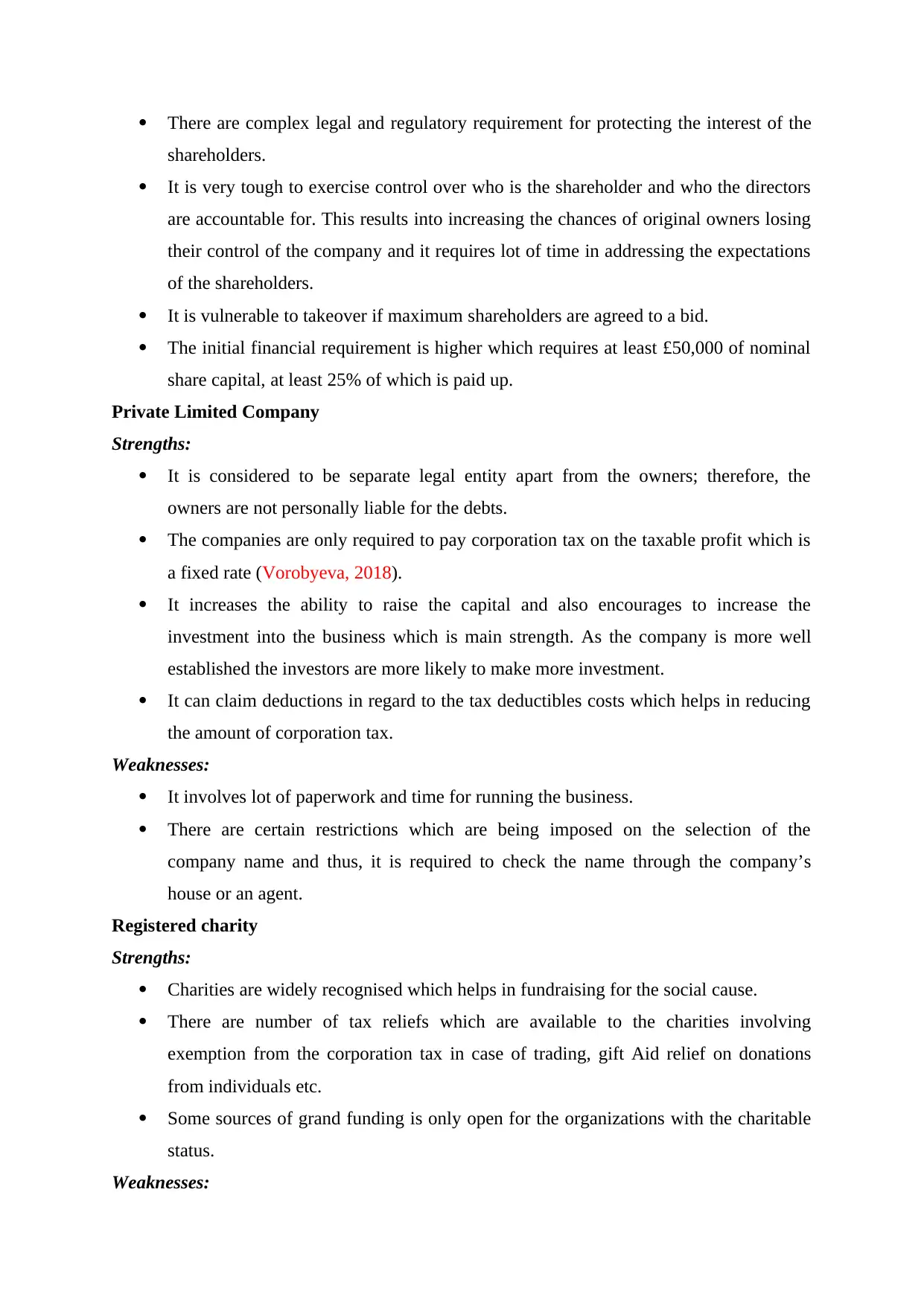
There are complex legal and regulatory requirement for protecting the interest of the
shareholders.
It is very tough to exercise control over who is the shareholder and who the directors
are accountable for. This results into increasing the chances of original owners losing
their control of the company and it requires lot of time in addressing the expectations
of the shareholders.
It is vulnerable to takeover if maximum shareholders are agreed to a bid.
The initial financial requirement is higher which requires at least £50,000 of nominal
share capital, at least 25% of which is paid up.
Private Limited Company
Strengths:
It is considered to be separate legal entity apart from the owners; therefore, the
owners are not personally liable for the debts.
The companies are only required to pay corporation tax on the taxable profit which is
a fixed rate (Vorobyeva, 2018).
It increases the ability to raise the capital and also encourages to increase the
investment into the business which is main strength. As the company is more well
established the investors are more likely to make more investment.
It can claim deductions in regard to the tax deductibles costs which helps in reducing
the amount of corporation tax.
Weaknesses:
It involves lot of paperwork and time for running the business.
There are certain restrictions which are being imposed on the selection of the
company name and thus, it is required to check the name through the company’s
house or an agent.
Registered charity
Strengths:
Charities are widely recognised which helps in fundraising for the social cause.
There are number of tax reliefs which are available to the charities involving
exemption from the corporation tax in case of trading, gift Aid relief on donations
from individuals etc.
Some sources of grand funding is only open for the organizations with the charitable
status.
Weaknesses:
shareholders.
It is very tough to exercise control over who is the shareholder and who the directors
are accountable for. This results into increasing the chances of original owners losing
their control of the company and it requires lot of time in addressing the expectations
of the shareholders.
It is vulnerable to takeover if maximum shareholders are agreed to a bid.
The initial financial requirement is higher which requires at least £50,000 of nominal
share capital, at least 25% of which is paid up.
Private Limited Company
Strengths:
It is considered to be separate legal entity apart from the owners; therefore, the
owners are not personally liable for the debts.
The companies are only required to pay corporation tax on the taxable profit which is
a fixed rate (Vorobyeva, 2018).
It increases the ability to raise the capital and also encourages to increase the
investment into the business which is main strength. As the company is more well
established the investors are more likely to make more investment.
It can claim deductions in regard to the tax deductibles costs which helps in reducing
the amount of corporation tax.
Weaknesses:
It involves lot of paperwork and time for running the business.
There are certain restrictions which are being imposed on the selection of the
company name and thus, it is required to check the name through the company’s
house or an agent.
Registered charity
Strengths:
Charities are widely recognised which helps in fundraising for the social cause.
There are number of tax reliefs which are available to the charities involving
exemption from the corporation tax in case of trading, gift Aid relief on donations
from individuals etc.
Some sources of grand funding is only open for the organizations with the charitable
status.
Weaknesses:
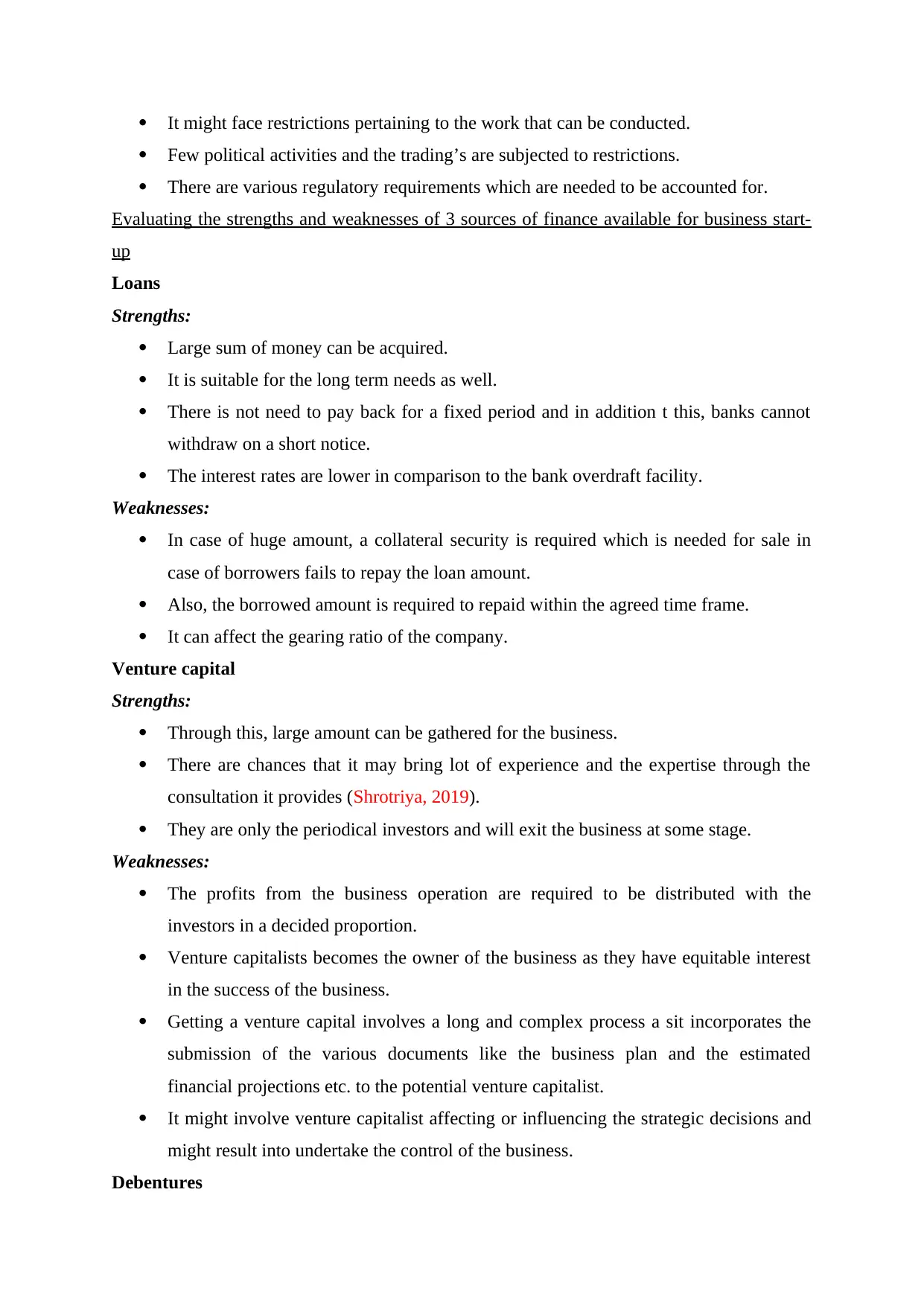
It might face restrictions pertaining to the work that can be conducted.
Few political activities and the trading’s are subjected to restrictions.
There are various regulatory requirements which are needed to be accounted for.
Evaluating the strengths and weaknesses of 3 sources of finance available for business start-
up
Loans
Strengths:
Large sum of money can be acquired.
It is suitable for the long term needs as well.
There is not need to pay back for a fixed period and in addition t this, banks cannot
withdraw on a short notice.
The interest rates are lower in comparison to the bank overdraft facility.
Weaknesses:
In case of huge amount, a collateral security is required which is needed for sale in
case of borrowers fails to repay the loan amount.
Also, the borrowed amount is required to repaid within the agreed time frame.
It can affect the gearing ratio of the company.
Venture capital
Strengths:
Through this, large amount can be gathered for the business.
There are chances that it may bring lot of experience and the expertise through the
consultation it provides (Shrotriya, 2019).
They are only the periodical investors and will exit the business at some stage.
Weaknesses:
The profits from the business operation are required to be distributed with the
investors in a decided proportion.
Venture capitalists becomes the owner of the business as they have equitable interest
in the success of the business.
Getting a venture capital involves a long and complex process a sit incorporates the
submission of the various documents like the business plan and the estimated
financial projections etc. to the potential venture capitalist.
It might involve venture capitalist affecting or influencing the strategic decisions and
might result into undertake the control of the business.
Debentures
Few political activities and the trading’s are subjected to restrictions.
There are various regulatory requirements which are needed to be accounted for.
Evaluating the strengths and weaknesses of 3 sources of finance available for business start-
up
Loans
Strengths:
Large sum of money can be acquired.
It is suitable for the long term needs as well.
There is not need to pay back for a fixed period and in addition t this, banks cannot
withdraw on a short notice.
The interest rates are lower in comparison to the bank overdraft facility.
Weaknesses:
In case of huge amount, a collateral security is required which is needed for sale in
case of borrowers fails to repay the loan amount.
Also, the borrowed amount is required to repaid within the agreed time frame.
It can affect the gearing ratio of the company.
Venture capital
Strengths:
Through this, large amount can be gathered for the business.
There are chances that it may bring lot of experience and the expertise through the
consultation it provides (Shrotriya, 2019).
They are only the periodical investors and will exit the business at some stage.
Weaknesses:
The profits from the business operation are required to be distributed with the
investors in a decided proportion.
Venture capitalists becomes the owner of the business as they have equitable interest
in the success of the business.
Getting a venture capital involves a long and complex process a sit incorporates the
submission of the various documents like the business plan and the estimated
financial projections etc. to the potential venture capitalist.
It might involve venture capitalist affecting or influencing the strategic decisions and
might result into undertake the control of the business.
Debentures
⊘ This is a preview!⊘
Do you want full access?
Subscribe today to unlock all pages.

Trusted by 1+ million students worldwide
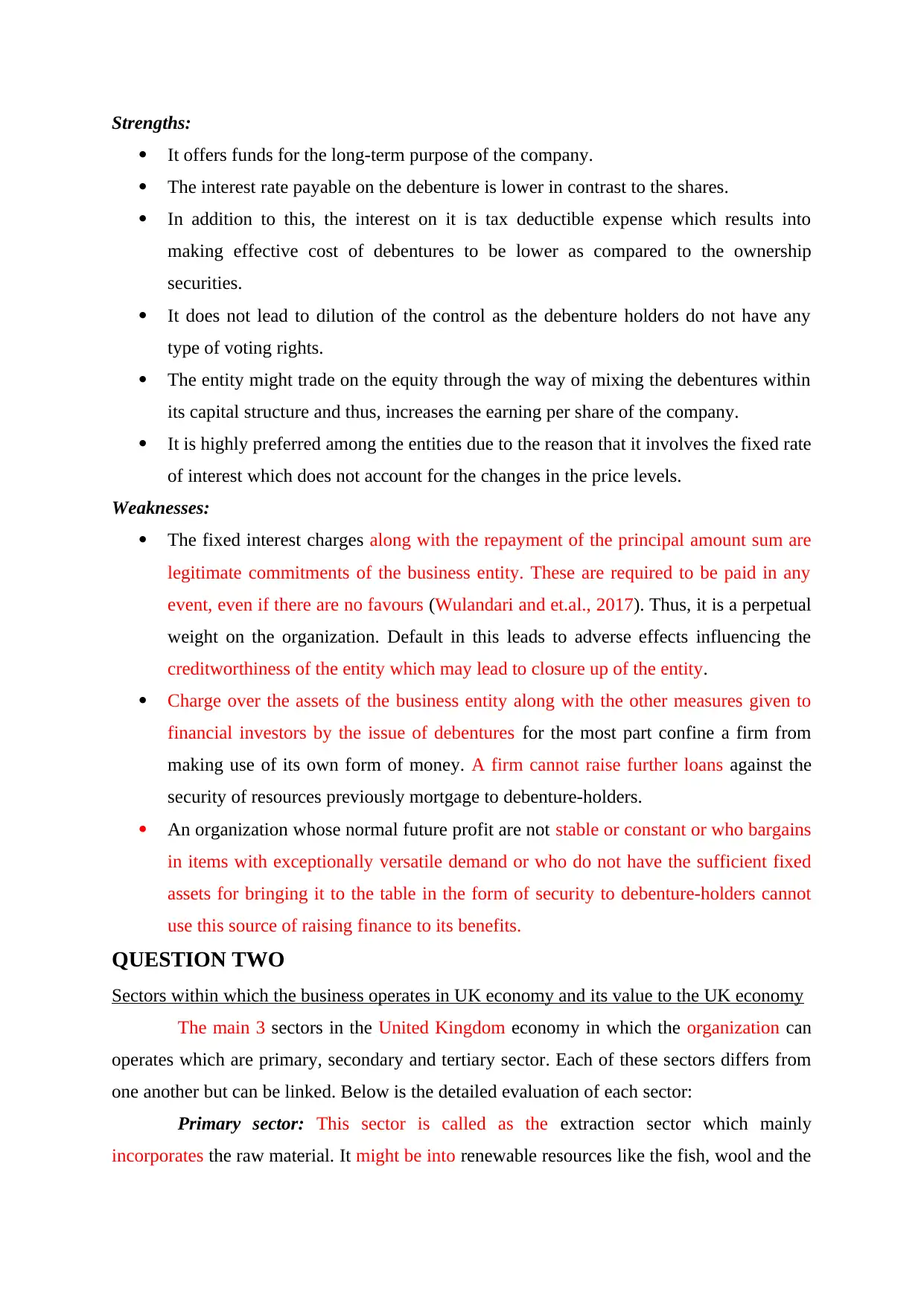
Strengths:
It offers funds for the long-term purpose of the company.
The interest rate payable on the debenture is lower in contrast to the shares.
In addition to this, the interest on it is tax deductible expense which results into
making effective cost of debentures to be lower as compared to the ownership
securities.
It does not lead to dilution of the control as the debenture holders do not have any
type of voting rights.
The entity might trade on the equity through the way of mixing the debentures within
its capital structure and thus, increases the earning per share of the company.
It is highly preferred among the entities due to the reason that it involves the fixed rate
of interest which does not account for the changes in the price levels.
Weaknesses:
The fixed interest charges along with the repayment of the principal amount sum are
legitimate commitments of the business entity. These are required to be paid in any
event, even if there are no favours (Wulandari and et.al., 2017). Thus, it is a perpetual
weight on the organization. Default in this leads to adverse effects influencing the
creditworthiness of the entity which may lead to closure up of the entity.
Charge over the assets of the business entity along with the other measures given to
financial investors by the issue of debentures for the most part confine a firm from
making use of its own form of money. A firm cannot raise further loans against the
security of resources previously mortgage to debenture-holders.
An organization whose normal future profit are not stable or constant or who bargains
in items with exceptionally versatile demand or who do not have the sufficient fixed
assets for bringing it to the table in the form of security to debenture-holders cannot
use this source of raising finance to its benefits.
QUESTION TWO
Sectors within which the business operates in UK economy and its value to the UK economy
The main 3 sectors in the United Kingdom economy in which the organization can
operates which are primary, secondary and tertiary sector. Each of these sectors differs from
one another but can be linked. Below is the detailed evaluation of each sector:
Primary sector: This sector is called as the extraction sector which mainly
incorporates the raw material. It might be into renewable resources like the fish, wool and the
It offers funds for the long-term purpose of the company.
The interest rate payable on the debenture is lower in contrast to the shares.
In addition to this, the interest on it is tax deductible expense which results into
making effective cost of debentures to be lower as compared to the ownership
securities.
It does not lead to dilution of the control as the debenture holders do not have any
type of voting rights.
The entity might trade on the equity through the way of mixing the debentures within
its capital structure and thus, increases the earning per share of the company.
It is highly preferred among the entities due to the reason that it involves the fixed rate
of interest which does not account for the changes in the price levels.
Weaknesses:
The fixed interest charges along with the repayment of the principal amount sum are
legitimate commitments of the business entity. These are required to be paid in any
event, even if there are no favours (Wulandari and et.al., 2017). Thus, it is a perpetual
weight on the organization. Default in this leads to adverse effects influencing the
creditworthiness of the entity which may lead to closure up of the entity.
Charge over the assets of the business entity along with the other measures given to
financial investors by the issue of debentures for the most part confine a firm from
making use of its own form of money. A firm cannot raise further loans against the
security of resources previously mortgage to debenture-holders.
An organization whose normal future profit are not stable or constant or who bargains
in items with exceptionally versatile demand or who do not have the sufficient fixed
assets for bringing it to the table in the form of security to debenture-holders cannot
use this source of raising finance to its benefits.
QUESTION TWO
Sectors within which the business operates in UK economy and its value to the UK economy
The main 3 sectors in the United Kingdom economy in which the organization can
operates which are primary, secondary and tertiary sector. Each of these sectors differs from
one another but can be linked. Below is the detailed evaluation of each sector:
Primary sector: This sector is called as the extraction sector which mainly
incorporates the raw material. It might be into renewable resources like the fish, wool and the
Paraphrase This Document
Need a fresh take? Get an instant paraphrase of this document with our AI Paraphraser
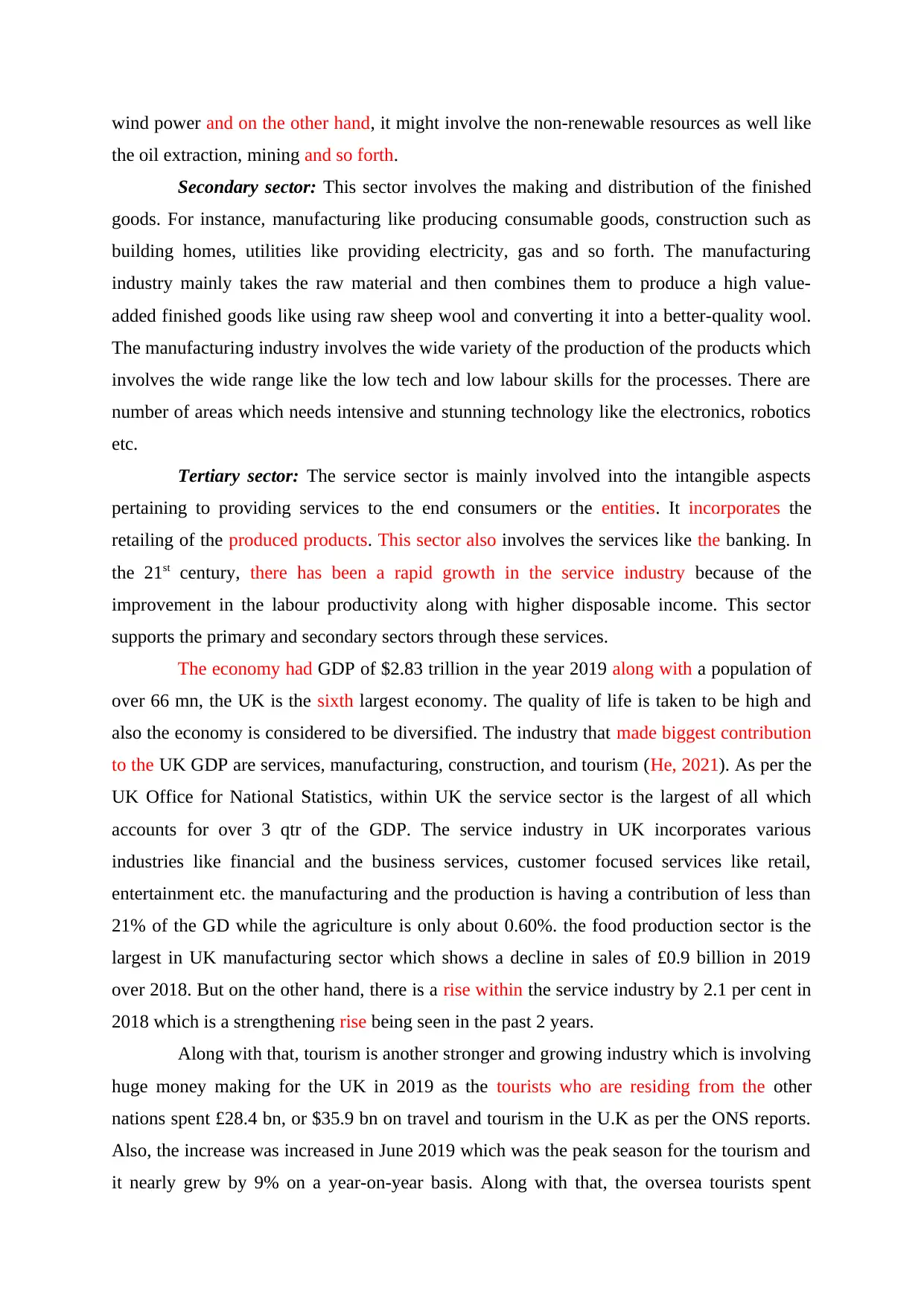
wind power and on the other hand, it might involve the non-renewable resources as well like
the oil extraction, mining and so forth.
Secondary sector: This sector involves the making and distribution of the finished
goods. For instance, manufacturing like producing consumable goods, construction such as
building homes, utilities like providing electricity, gas and so forth. The manufacturing
industry mainly takes the raw material and then combines them to produce a high value-
added finished goods like using raw sheep wool and converting it into a better-quality wool.
The manufacturing industry involves the wide variety of the production of the products which
involves the wide range like the low tech and low labour skills for the processes. There are
number of areas which needs intensive and stunning technology like the electronics, robotics
etc.
Tertiary sector: The service sector is mainly involved into the intangible aspects
pertaining to providing services to the end consumers or the entities. It incorporates the
retailing of the produced products. This sector also involves the services like the banking. In
the 21st century, there has been a rapid growth in the service industry because of the
improvement in the labour productivity along with higher disposable income. This sector
supports the primary and secondary sectors through these services.
The economy had GDP of $2.83 trillion in the year 2019 along with a population of
over 66 mn, the UK is the sixth largest economy. The quality of life is taken to be high and
also the economy is considered to be diversified. The industry that made biggest contribution
to the UK GDP are services, manufacturing, construction, and tourism (He, 2021). As per the
UK Office for National Statistics, within UK the service sector is the largest of all which
accounts for over 3 qtr of the GDP. The service industry in UK incorporates various
industries like financial and the business services, customer focused services like retail,
entertainment etc. the manufacturing and the production is having a contribution of less than
21% of the GD while the agriculture is only about 0.60%. the food production sector is the
largest in UK manufacturing sector which shows a decline in sales of £0.9 billion in 2019
over 2018. But on the other hand, there is a rise within the service industry by 2.1 per cent in
2018 which is a strengthening rise being seen in the past 2 years.
Along with that, tourism is another stronger and growing industry which is involving
huge money making for the UK in 2019 as the tourists who are residing from the other
nations spent £28.4 bn, or $35.9 bn on travel and tourism in the U.K as per the ONS reports.
Also, the increase was increased in June 2019 which was the peak season for the tourism and
it nearly grew by 9% on a year-on-year basis. Along with that, the oversea tourists spent
the oil extraction, mining and so forth.
Secondary sector: This sector involves the making and distribution of the finished
goods. For instance, manufacturing like producing consumable goods, construction such as
building homes, utilities like providing electricity, gas and so forth. The manufacturing
industry mainly takes the raw material and then combines them to produce a high value-
added finished goods like using raw sheep wool and converting it into a better-quality wool.
The manufacturing industry involves the wide variety of the production of the products which
involves the wide range like the low tech and low labour skills for the processes. There are
number of areas which needs intensive and stunning technology like the electronics, robotics
etc.
Tertiary sector: The service sector is mainly involved into the intangible aspects
pertaining to providing services to the end consumers or the entities. It incorporates the
retailing of the produced products. This sector also involves the services like the banking. In
the 21st century, there has been a rapid growth in the service industry because of the
improvement in the labour productivity along with higher disposable income. This sector
supports the primary and secondary sectors through these services.
The economy had GDP of $2.83 trillion in the year 2019 along with a population of
over 66 mn, the UK is the sixth largest economy. The quality of life is taken to be high and
also the economy is considered to be diversified. The industry that made biggest contribution
to the UK GDP are services, manufacturing, construction, and tourism (He, 2021). As per the
UK Office for National Statistics, within UK the service sector is the largest of all which
accounts for over 3 qtr of the GDP. The service industry in UK incorporates various
industries like financial and the business services, customer focused services like retail,
entertainment etc. the manufacturing and the production is having a contribution of less than
21% of the GD while the agriculture is only about 0.60%. the food production sector is the
largest in UK manufacturing sector which shows a decline in sales of £0.9 billion in 2019
over 2018. But on the other hand, there is a rise within the service industry by 2.1 per cent in
2018 which is a strengthening rise being seen in the past 2 years.
Along with that, tourism is another stronger and growing industry which is involving
huge money making for the UK in 2019 as the tourists who are residing from the other
nations spent £28.4 bn, or $35.9 bn on travel and tourism in the U.K as per the ONS reports.
Also, the increase was increased in June 2019 which was the peak season for the tourism and
it nearly grew by 9% on a year-on-year basis. Along with that, the oversea tourists spent
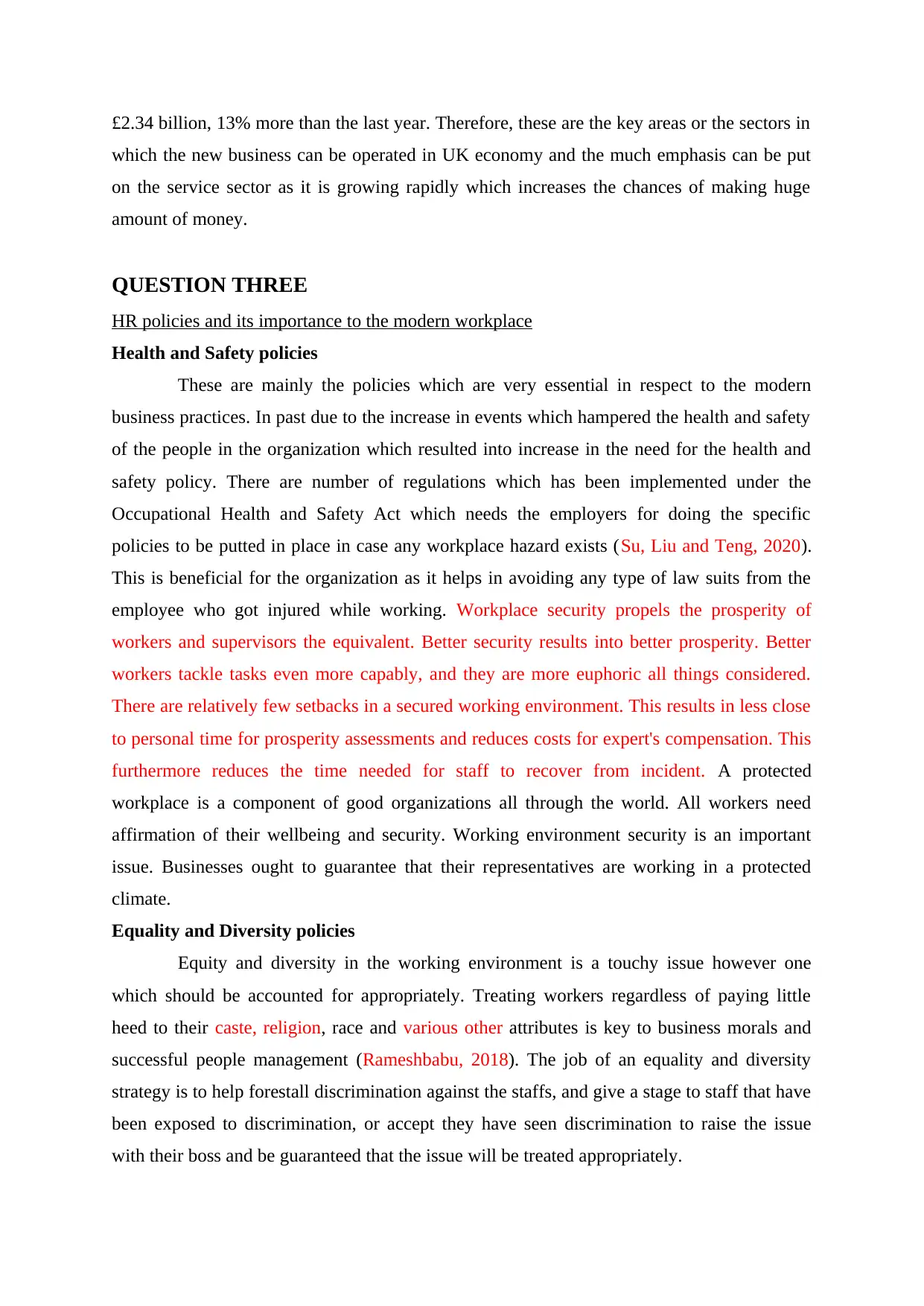
£2.34 billion, 13% more than the last year. Therefore, these are the key areas or the sectors in
which the new business can be operated in UK economy and the much emphasis can be put
on the service sector as it is growing rapidly which increases the chances of making huge
amount of money.
QUESTION THREE
HR policies and its importance to the modern workplace
Health and Safety policies
These are mainly the policies which are very essential in respect to the modern
business practices. In past due to the increase in events which hampered the health and safety
of the people in the organization which resulted into increase in the need for the health and
safety policy. There are number of regulations which has been implemented under the
Occupational Health and Safety Act which needs the employers for doing the specific
policies to be putted in place in case any workplace hazard exists (Su, Liu and Teng, 2020).
This is beneficial for the organization as it helps in avoiding any type of law suits from the
employee who got injured while working. Workplace security propels the prosperity of
workers and supervisors the equivalent. Better security results into better prosperity. Better
workers tackle tasks even more capably, and they are more euphoric all things considered.
There are relatively few setbacks in a secured working environment. This results in less close
to personal time for prosperity assessments and reduces costs for expert's compensation. This
furthermore reduces the time needed for staff to recover from incident. A protected
workplace is a component of good organizations all through the world. All workers need
affirmation of their wellbeing and security. Working environment security is an important
issue. Businesses ought to guarantee that their representatives are working in a protected
climate.
Equality and Diversity policies
Equity and diversity in the working environment is a touchy issue however one
which should be accounted for appropriately. Treating workers regardless of paying little
heed to their caste, religion, race and various other attributes is key to business morals and
successful people management (Rameshbabu, 2018). The job of an equality and diversity
strategy is to help forestall discrimination against the staffs, and give a stage to staff that have
been exposed to discrimination, or accept they have seen discrimination to raise the issue
with their boss and be guaranteed that the issue will be treated appropriately.
which the new business can be operated in UK economy and the much emphasis can be put
on the service sector as it is growing rapidly which increases the chances of making huge
amount of money.
QUESTION THREE
HR policies and its importance to the modern workplace
Health and Safety policies
These are mainly the policies which are very essential in respect to the modern
business practices. In past due to the increase in events which hampered the health and safety
of the people in the organization which resulted into increase in the need for the health and
safety policy. There are number of regulations which has been implemented under the
Occupational Health and Safety Act which needs the employers for doing the specific
policies to be putted in place in case any workplace hazard exists (Su, Liu and Teng, 2020).
This is beneficial for the organization as it helps in avoiding any type of law suits from the
employee who got injured while working. Workplace security propels the prosperity of
workers and supervisors the equivalent. Better security results into better prosperity. Better
workers tackle tasks even more capably, and they are more euphoric all things considered.
There are relatively few setbacks in a secured working environment. This results in less close
to personal time for prosperity assessments and reduces costs for expert's compensation. This
furthermore reduces the time needed for staff to recover from incident. A protected
workplace is a component of good organizations all through the world. All workers need
affirmation of their wellbeing and security. Working environment security is an important
issue. Businesses ought to guarantee that their representatives are working in a protected
climate.
Equality and Diversity policies
Equity and diversity in the working environment is a touchy issue however one
which should be accounted for appropriately. Treating workers regardless of paying little
heed to their caste, religion, race and various other attributes is key to business morals and
successful people management (Rameshbabu, 2018). The job of an equality and diversity
strategy is to help forestall discrimination against the staffs, and give a stage to staff that have
been exposed to discrimination, or accept they have seen discrimination to raise the issue
with their boss and be guaranteed that the issue will be treated appropriately.
⊘ This is a preview!⊘
Do you want full access?
Subscribe today to unlock all pages.

Trusted by 1+ million students worldwide
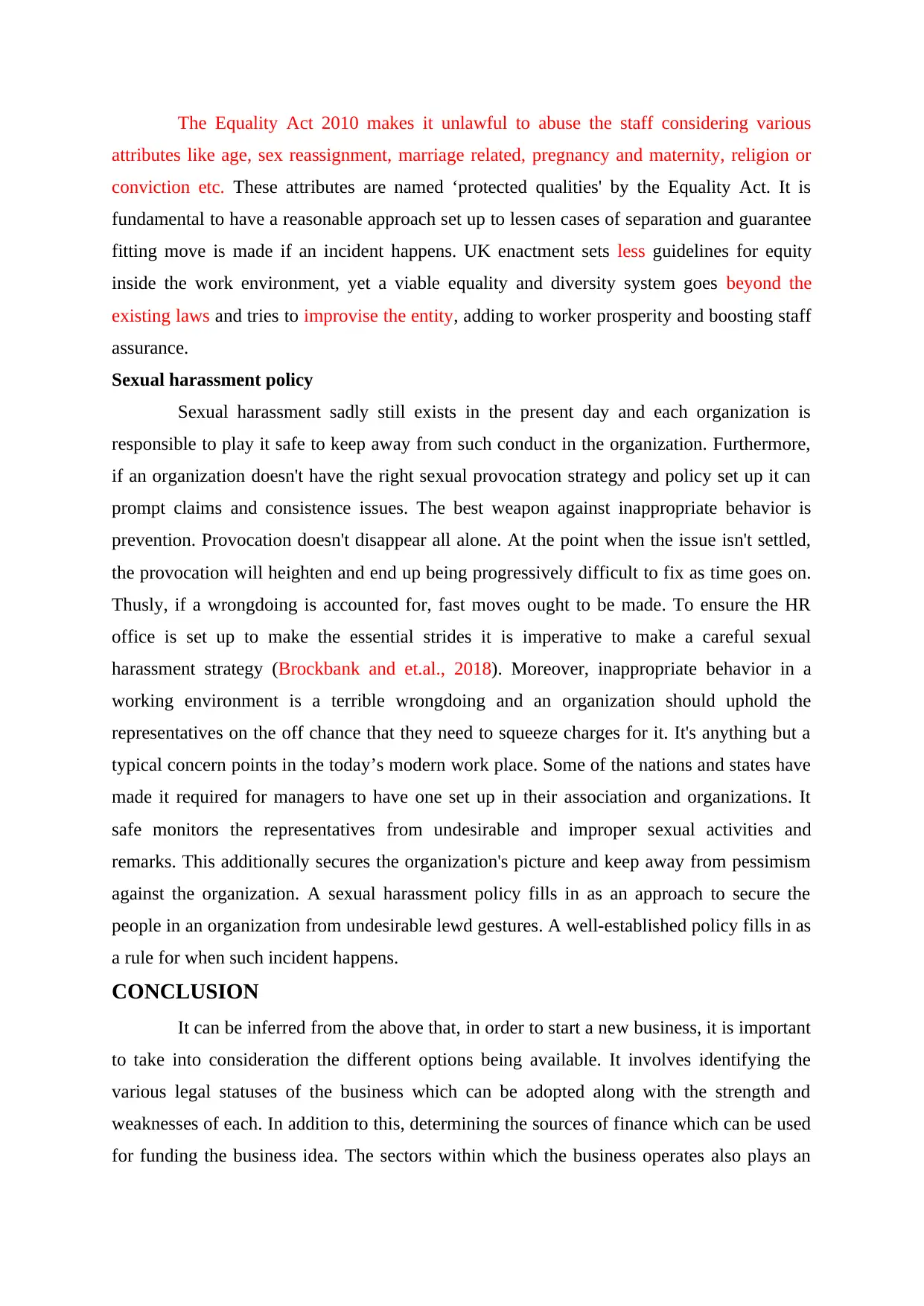
The Equality Act 2010 makes it unlawful to abuse the staff considering various
attributes like age, sex reassignment, marriage related, pregnancy and maternity, religion or
conviction etc. These attributes are named ‘protected qualities' by the Equality Act. It is
fundamental to have a reasonable approach set up to lessen cases of separation and guarantee
fitting move is made if an incident happens. UK enactment sets less guidelines for equity
inside the work environment, yet a viable equality and diversity system goes beyond the
existing laws and tries to improvise the entity, adding to worker prosperity and boosting staff
assurance.
Sexual harassment policy
Sexual harassment sadly still exists in the present day and each organization is
responsible to play it safe to keep away from such conduct in the organization. Furthermore,
if an organization doesn't have the right sexual provocation strategy and policy set up it can
prompt claims and consistence issues. The best weapon against inappropriate behavior is
prevention. Provocation doesn't disappear all alone. At the point when the issue isn't settled,
the provocation will heighten and end up being progressively difficult to fix as time goes on.
Thusly, if a wrongdoing is accounted for, fast moves ought to be made. To ensure the HR
office is set up to make the essential strides it is imperative to make a careful sexual
harassment strategy (Brockbank and et.al., 2018). Moreover, inappropriate behavior in a
working environment is a terrible wrongdoing and an organization should uphold the
representatives on the off chance that they need to squeeze charges for it. It's anything but a
typical concern points in the today’s modern work place. Some of the nations and states have
made it required for managers to have one set up in their association and organizations. It
safe monitors the representatives from undesirable and improper sexual activities and
remarks. This additionally secures the organization's picture and keep away from pessimism
against the organization. A sexual harassment policy fills in as an approach to secure the
people in an organization from undesirable lewd gestures. A well-established policy fills in as
a rule for when such incident happens.
CONCLUSION
It can be inferred from the above that, in order to start a new business, it is important
to take into consideration the different options being available. It involves identifying the
various legal statuses of the business which can be adopted along with the strength and
weaknesses of each. In addition to this, determining the sources of finance which can be used
for funding the business idea. The sectors within which the business operates also plays an
attributes like age, sex reassignment, marriage related, pregnancy and maternity, religion or
conviction etc. These attributes are named ‘protected qualities' by the Equality Act. It is
fundamental to have a reasonable approach set up to lessen cases of separation and guarantee
fitting move is made if an incident happens. UK enactment sets less guidelines for equity
inside the work environment, yet a viable equality and diversity system goes beyond the
existing laws and tries to improvise the entity, adding to worker prosperity and boosting staff
assurance.
Sexual harassment policy
Sexual harassment sadly still exists in the present day and each organization is
responsible to play it safe to keep away from such conduct in the organization. Furthermore,
if an organization doesn't have the right sexual provocation strategy and policy set up it can
prompt claims and consistence issues. The best weapon against inappropriate behavior is
prevention. Provocation doesn't disappear all alone. At the point when the issue isn't settled,
the provocation will heighten and end up being progressively difficult to fix as time goes on.
Thusly, if a wrongdoing is accounted for, fast moves ought to be made. To ensure the HR
office is set up to make the essential strides it is imperative to make a careful sexual
harassment strategy (Brockbank and et.al., 2018). Moreover, inappropriate behavior in a
working environment is a terrible wrongdoing and an organization should uphold the
representatives on the off chance that they need to squeeze charges for it. It's anything but a
typical concern points in the today’s modern work place. Some of the nations and states have
made it required for managers to have one set up in their association and organizations. It
safe monitors the representatives from undesirable and improper sexual activities and
remarks. This additionally secures the organization's picture and keep away from pessimism
against the organization. A sexual harassment policy fills in as an approach to secure the
people in an organization from undesirable lewd gestures. A well-established policy fills in as
a rule for when such incident happens.
CONCLUSION
It can be inferred from the above that, in order to start a new business, it is important
to take into consideration the different options being available. It involves identifying the
various legal statuses of the business which can be adopted along with the strength and
weaknesses of each. In addition to this, determining the sources of finance which can be used
for funding the business idea. The sectors within which the business operates also plays an
Paraphrase This Document
Need a fresh take? Get an instant paraphrase of this document with our AI Paraphraser

important role as it determines how much value it adds to the UK economy. Implementing
crucial HR policies is also important as it helps in ensuring well-being of the employees and
the reputation of the entity as well.
crucial HR policies is also important as it helps in ensuring well-being of the employees and
the reputation of the entity as well.
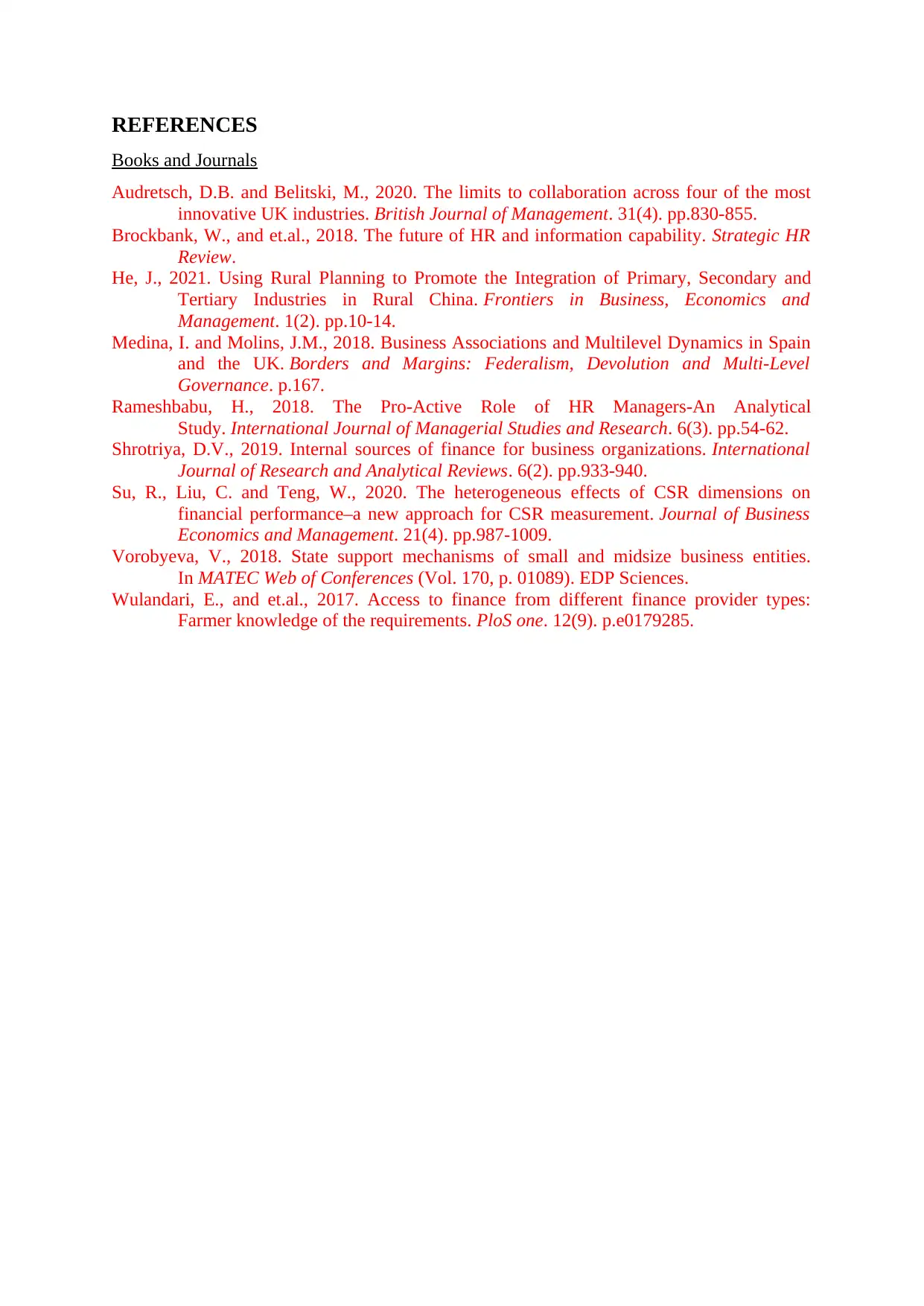
REFERENCES
Books and Journals
Audretsch, D.B. and Belitski, M., 2020. The limits to collaboration across four of the most
innovative UK industries. British Journal of Management. 31(4). pp.830-855.
Brockbank, W., and et.al., 2018. The future of HR and information capability. Strategic HR
Review.
He, J., 2021. Using Rural Planning to Promote the Integration of Primary, Secondary and
Tertiary Industries in Rural China. Frontiers in Business, Economics and
Management. 1(2). pp.10-14.
Medina, I. and Molins, J.M., 2018. Business Associations and Multilevel Dynamics in Spain
and the UK. Borders and Margins: Federalism, Devolution and Multi-Level
Governance. p.167.
Rameshbabu, H., 2018. The Pro-Active Role of HR Managers-An Analytical
Study. International Journal of Managerial Studies and Research. 6(3). pp.54-62.
Shrotriya, D.V., 2019. Internal sources of finance for business organizations. International
Journal of Research and Analytical Reviews. 6(2). pp.933-940.
Su, R., Liu, C. and Teng, W., 2020. The heterogeneous effects of CSR dimensions on
financial performance–a new approach for CSR measurement. Journal of Business
Economics and Management. 21(4). pp.987-1009.
Vorobyeva, V., 2018. State support mechanisms of small and midsize business entities.
In MATEC Web of Conferences (Vol. 170, p. 01089). EDP Sciences.
Wulandari, E., and et.al., 2017. Access to finance from different finance provider types:
Farmer knowledge of the requirements. PloS one. 12(9). p.e0179285.
Books and Journals
Audretsch, D.B. and Belitski, M., 2020. The limits to collaboration across four of the most
innovative UK industries. British Journal of Management. 31(4). pp.830-855.
Brockbank, W., and et.al., 2018. The future of HR and information capability. Strategic HR
Review.
He, J., 2021. Using Rural Planning to Promote the Integration of Primary, Secondary and
Tertiary Industries in Rural China. Frontiers in Business, Economics and
Management. 1(2). pp.10-14.
Medina, I. and Molins, J.M., 2018. Business Associations and Multilevel Dynamics in Spain
and the UK. Borders and Margins: Federalism, Devolution and Multi-Level
Governance. p.167.
Rameshbabu, H., 2018. The Pro-Active Role of HR Managers-An Analytical
Study. International Journal of Managerial Studies and Research. 6(3). pp.54-62.
Shrotriya, D.V., 2019. Internal sources of finance for business organizations. International
Journal of Research and Analytical Reviews. 6(2). pp.933-940.
Su, R., Liu, C. and Teng, W., 2020. The heterogeneous effects of CSR dimensions on
financial performance–a new approach for CSR measurement. Journal of Business
Economics and Management. 21(4). pp.987-1009.
Vorobyeva, V., 2018. State support mechanisms of small and midsize business entities.
In MATEC Web of Conferences (Vol. 170, p. 01089). EDP Sciences.
Wulandari, E., and et.al., 2017. Access to finance from different finance provider types:
Farmer knowledge of the requirements. PloS one. 12(9). p.e0179285.
⊘ This is a preview!⊘
Do you want full access?
Subscribe today to unlock all pages.

Trusted by 1+ million students worldwide
1 out of 12
Related Documents
Your All-in-One AI-Powered Toolkit for Academic Success.
+13062052269
info@desklib.com
Available 24*7 on WhatsApp / Email
![[object Object]](/_next/static/media/star-bottom.7253800d.svg)
Unlock your academic potential
Copyright © 2020–2025 A2Z Services. All Rights Reserved. Developed and managed by ZUCOL.





